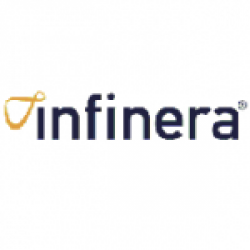Coherent Detection of 10x100Gb/s Channels
Sunnyvale, CA on 7 March 2011
Infinera (Nasdaq: INFN) will present the results of the world’s first 1 Terabit/second (Tb/s) photonic integrated circuit (PIC) at next week’s Optical Fiber Conference. The 1 Tb/s PIC represents another step forward in the evolution of PIC technology to higher levels of integration and higher data rates.
The talk, by Dr. Radhakrishnan Nagarajan, Infinera research fellow and member of the PIC development team, will describe the structure and performance of a 1 Tb/s PIC receiver. The receiver receives and decodes ten channels of 100Gb/s each, using the QPSK modulation format and coherent detection. The receiver integrates more than 150 optical devices on a single monolithic Indium Phosphide chip.
“With PICs, Infinera has applied the manufacturing techniques of the Silicon industry to optics, and we expect we will be able to ride a long-term curve of more integration, greater functionality, higher data rates, and improved reliability, at the component level, system level, and network level,” said Dr. Nagarajan.
With Internet traffic growing at exponential rates, driven by video, cloud computing, and mobility, PIC technology will be required to support the growth of network capacity to accommodate this traffic, while reducing the per-bit cost, space, and power consumption, to enable service providers to carry the traffic while maintaining profitable business models. Photonic integration enables greater network reliability because connections between optical components are printed directly onto a chip. From a network architecture point of view, Terabit PICs could enable the use of “superchannels” or groups of data channels bonded together to enable more efficient use of network resources and the optical spectrum. At the consumer level, a 1 Tb/s PIC could enable the download of one high-definition movie file in a fifth of a second, or support the transmission of two million simultaneous videoconferences—all from a single pair of chips.
Terabits and Superchannels
In 2004, Infinera began shipping optical systems based on 100Gb/s PICs. In less than two years, Infinera systems seized first place in the North American long-haul optical networking market, according to data from independent analysts the Dell’Oro Group. Earlier this week, in partnership with pan-European service provider Interoute, Infinera announced the results of the latest field trial of its next generation of commercial PICs, which deliver 500Gb/s of capacity on a single pair of chips. Optical systems based on the 500Gb/s PICs are planned for commercial availability next year. The 1 Tb/s PIC represents another leap forward in the evolution of photonic integration.
Dr. Nagarajan will be presenting “10 Channel, 100Gbit/s per Channel, Dual Polarization, Coherent QPSK, Monolithic InP Receiver Photonic Integrated Circuit” on Monday, March 7th at 3:15 pm.
About Infinera
Infinera provides Digital Optical Networking systems to telecommunications carriers worldwide. Infinera’s systems are unique in their use of a breakthrough semiconductor technology: the photonic integrated circuit (PIC). Infinera’s systems and PIC technology are designed to provide customers with simpler and more flexible engineering and operations, faster time-to-service, and the ability to rapidly deliver differentiated services without reengineering their optical infrastructure. For more information, please visit http://www.infinera.com/.
This press release contains certain forward-looking statements based on current expectations, forecasts and assumptions that involve risks and uncertainties. These statements are based on information available to Infinera as of the date hereof; and actual results could differ materially from those stated or implied, due to risks and uncertainties. Forward-looking statements include statements regarding Infinera’s expectations, beliefs, intentions or strategies regarding the future, including Infinera will present the results of the world’s first 1 Terabit/second (Tb/s) photonic integrated circuit (PIC) at next week’s Optical Fiber Conference; that the 1 Tb/s PIC represents another step forward in the evolution of PIC technology to higher levels of integration and higher data rates; that Infinera expects to be able to ride a long-term curve of more integration, greater functionality, higher data rates, and improved reliability, at the component level, system level, and network level; that PIC technology will be required to support the growth of network capacity to accommodate this traffic, while reducing the per-bit cost, space, and power consumption, to enable service providers to carry the traffic while maintaining profitable business models; that photonic integration enables greater network reliability; that Terabit PICs could enable the use of “superchannels”, or groups of data channels bonded together to enable more efficient use of network resources and the optical spectrum; that at the consumer level, a 1 Tb/s PIC could enable the download of one high-definition movie file in a fifth of a second, or support the transmission of two million simultaneous videoconferences—all from a single pair of chips; that Optical systems based on the 500Gb/s PICs are planned for commercial availability next year; and that the 1 Tb/s PIC represents another leap forward in the evolution of photonic integration. Such forward-looking statements can be identified by forward-looking words such as “anticipated,” “believed,” “could,” “estimate,” “expect,” “intend,” “may,” “should,” “will,” and “would” or similar words. The risks and uncertainties that could cause our results to differ materially from those expressed or implied by such forward-looking statements include aggressive business tactics by our competitors, our dependence on a single product, our ability to protect our intellectual property, claims by others that we infringe their intellectual property, and our ability to respond to rapid technological changes, and other risks that may impact any of the group’s business are set forth in their annual reports on Form 10-K filed with the SEC on March 1, 2011, as well as subsequent reports filed with or furnished to the Securities and Exchange Commission. These statements are based on information available to us as of the date hereof and we disclaim any obligation to update the forward-looking statements included in this press release, whether as a result of new information, future events or otherwise.




